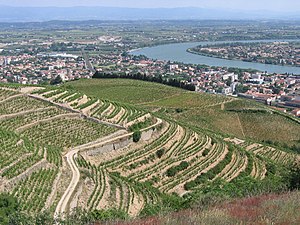Tain-l'Hermitage
| Tain-l'Hermitage | ||
|---|---|---|

|
|
|
| region | Auvergne-Rhône-Alpes | |
| Department | Drôme | |
| Arrondissement | Valence | |
| Canton | Tain-l'Hermitage (main town) | |
| Community association | Hermitage-Tournonais-Herbasse-Pays de Saint Félicien | |
| Coordinates | 45 ° 4 ′ N , 4 ° 51 ′ E | |
| height | 115-280 m | |
| surface | 4.85 km 2 | |
| Residents | 6,162 (January 1, 2017) | |
| Population density | 1,271 inhabitants / km 2 | |
| Post Code | 26600 | |
| INSEE code | 26347 | |
| Website | www.ville-tain.com | |
 Tain l'Hermitage on the left bank of the Rhone |
||
Tain-l'Hermitage , Tain before 1920 , is a French commune with 6,162 inhabitants (as of January 1, 2017) in the Drôme department ( Auvergne-Rhône-Alpes region ), about 80 kilometers south of Lyon on the Rhone . The river is spanned here by the suspension bridge Passerelle Marc Seguin , which connects Tain-l'Hermitage with the opposite Tournon-sur-Rhône . The small town lives mainly from wine production and increasingly from tourism.
Location and traffic
Tain-l'Hermitage is located on the A7 motorway between Lyon and Marseille with its own exit and on the RN7 national road . The place has a train station on the Paris – Marseille railway line as well as a pier for passenger ships.
history
Tain developed from the Celtic settlement of Tegna (later Tinctum ) on the military road between the Mediterranean and central Europe. The settlement was surrounded by a city wall, of which the Batie Gate has been preserved to this day . The Adret Tower , then built as an arms depot, and the bull sacrifice altar from AD 184 also date from Roman times . The sacrificial stone was originally located near the Temple of Hercules. After its removal it was buried. A hermit finally found it and sold it to an Englishman. However, the removal was prevented by two city consuls who instead arranged for it to be installed on Place Taurobole on the main street and placed it under monumental protection.
In the 12th century Tain was a fiefdom of the Dauphins of Viennois . Here, in the previous building of the Notre Dame de Tain church, the wedding of the Dauphin and future King Charles V with Joan of Bourbon took place in 1350 .
Population development
| year | 1962 | 1968 | 1975 | 1982 | 1990 | 1999 | 2006 | 2016 |
| Residents | 5077 | 5377 | 5563 | 5387 | 5003 | 5503 | 5764 | 6194 |
| Sources: Cassini and INSEE | ||||||||
economy
Viticulture is of great importance - Tain was therefore given the name Hermitage in 1920 as an addition to the city name after the most famous location . Tain l'Hermitage is the seat of a wine cooperative and several large trading houses. In addition to the Hermitage, Crozes-Hermitage and Saint-Joseph wines are also produced. Every year in the month of February a wine fair held. Tain is also the center of fruit growing in the Rhône Valley. Beyond the region, the chocolate industry ( Valrhona ) is also important.
Buildings (selection)
-
Notre Dame de Tain , a Catholic church from 1838.
It was the second new building of a church built in the 10th century. The first new church building was built after the wars of religion in the 16th century. The church tower was added in 1865 and has 13 bronze bells ringing .
-
Chapel of St. Christophe
It was built in 1100 on the site of a Roman temple dedicated to the god Hercules and belonged to the monastery of Saint-André-le-bas in Vienne . Users were hermits, from whom the name of the hill as Hermitage is derived. In 1861–1864 it was replaced by a new building. A Jaboulet family bought the building in 1919 and had it completely rebuilt in 1980. The small chapel stands on the Hermitage hill with a view over the Rhône, the Ardèche Mountains and the Pre-Alps. -
Salt store
It was built around 1550 by order of Charles VII . From then on, all salt deliveries for the Dauphiné had to be temporarily stored here and a salt tax was levied. This created a new line of business and the city was able to develop economically. The building lost its importance as a warehouse in 1630, but the regent of the city of Tain granted discounts on the purchase of the salt, which is mainly used for agriculture. - Footbridge (1849) by Marc Seguin over the river to Tournon-sur-Rhône ,
- Museum of the new École de Paris
- City Hall
The first administrative building of the city of Tain was built in 1807. In 1840 it received two additional side wings and was rebuilt in its current form in 1972.
Town twinning
City partnerships exist with
Personalities
- Elie Blanc (1846–1926), theologian, philosopher, lexicographer and Romanist
- Émile Friol (1881-1916), cyclist

